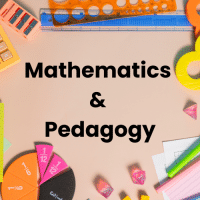CTET & State TET Exam > CTET & State TET Questions > Mathematical communication refers to:a)Abilit...
Start Learning for Free
Mathematical communication refers to:
- a)Ability to solve problems
- b)Skills to participate a Mathematics quiz
- c)Ability to speak in Mathematics classroom
- d)Ability to consolidate and organize mathematical thinking
Correct answer is option 'D'. Can you explain this answer?
| FREE This question is part of | Download PDF Attempt this Test |
Most Upvoted Answer
Mathematical communication refers to:a)Ability to solve problemsb)Skil...
Mathematical Communication refers to the communication by which learners discuss, share, analyze, and make sense of maths. It is used to express mathematical thoughts and ideas.
Communication in Mathematics develops the ability to organize, consolidate, and express mathematical thinking among students.
Aims of encouraging mathematical communication in the classroom:
Communication in Mathematics develops the ability to organize, consolidate, and express mathematical thinking among students.
Aims of encouraging mathematical communication in the classroom:
- Enabling learners to reason logically.
- Enhancing mathematical understanding.
- Making learners able to assimilate mathematical terms.
- Enabling learners to express mathematical thoughts and ideas.
- Developing the ability to recognize the patterns of mathematical thought.
- Enabling learners to use precise language while talking about mathematical statements and using them.
Hence, it could be concluded that Mathematical communication refers to the ability to consolidate and organize mathematical thinking.
Free Test
FREE
| Start Free Test |
Community Answer
Mathematical communication refers to:a)Ability to solve problemsb)Skil...
Ability to consolidate and organize mathematical thinking
Mathematical communication is the ability to effectively convey mathematical ideas, concepts, and solutions to others. This involves not only being able to solve mathematical problems but also to clearly explain the thought process and reasoning behind the solutions. Below are some key points explaining why the correct answer is the ability to consolidate and organize mathematical thinking:
Clarity and coherence
Mathematical communication requires individuals to clearly and coherently present their ideas and solutions. This involves organizing thoughts in a logical manner, using appropriate mathematical language, and providing sufficient explanations to support mathematical reasoning.
Connecting ideas
Effective mathematical communication involves connecting different mathematical ideas and concepts. This may include explaining how different mathematical principles relate to each other, identifying patterns or relationships, and synthesizing information to form a comprehensive understanding of a problem.
Justifying solutions
Mathematical communication also involves justifying solutions through logical reasoning. This may include providing proofs, explanations, or examples to support the validity of a solution. Justifying solutions helps to demonstrate a deep understanding of the mathematical concepts involved.
Engaging with others
Mathematical communication often involves engaging with others, whether it be through classroom discussions, group work, or presentations. Being able to communicate mathematical ideas effectively with peers, teachers, or other individuals fosters collaboration, understanding, and learning.
In conclusion, the ability to consolidate and organize mathematical thinking is essential for effective mathematical communication. By clearly conveying ideas, connecting concepts, justifying solutions, and engaging with others, individuals can enhance their mathematical communication skills and deepen their understanding of mathematical concepts.
Mathematical communication is the ability to effectively convey mathematical ideas, concepts, and solutions to others. This involves not only being able to solve mathematical problems but also to clearly explain the thought process and reasoning behind the solutions. Below are some key points explaining why the correct answer is the ability to consolidate and organize mathematical thinking:
Clarity and coherence
Mathematical communication requires individuals to clearly and coherently present their ideas and solutions. This involves organizing thoughts in a logical manner, using appropriate mathematical language, and providing sufficient explanations to support mathematical reasoning.
Connecting ideas
Effective mathematical communication involves connecting different mathematical ideas and concepts. This may include explaining how different mathematical principles relate to each other, identifying patterns or relationships, and synthesizing information to form a comprehensive understanding of a problem.
Justifying solutions
Mathematical communication also involves justifying solutions through logical reasoning. This may include providing proofs, explanations, or examples to support the validity of a solution. Justifying solutions helps to demonstrate a deep understanding of the mathematical concepts involved.
Engaging with others
Mathematical communication often involves engaging with others, whether it be through classroom discussions, group work, or presentations. Being able to communicate mathematical ideas effectively with peers, teachers, or other individuals fosters collaboration, understanding, and learning.
In conclusion, the ability to consolidate and organize mathematical thinking is essential for effective mathematical communication. By clearly conveying ideas, connecting concepts, justifying solutions, and engaging with others, individuals can enhance their mathematical communication skills and deepen their understanding of mathematical concepts.
Attention CTET & State TET Students!
To make sure you are not studying endlessly, EduRev has designed CTET & State TET study material, with Structured Courses, Videos, & Test Series. Plus get personalized analysis, doubt solving and improvement plans to achieve a great score in CTET & State TET.

|
Explore Courses for CTET & State TET exam
|

|
Similar CTET & State TET Doubts
Mathematical communication refers to:a)Ability to solve problemsb)Skills to participate a Mathematics quizc)Ability to speak in Mathematics classroomd)Ability to consolidate and organize mathematical thinkingCorrect answer is option 'D'. Can you explain this answer?
Question Description
Mathematical communication refers to:a)Ability to solve problemsb)Skills to participate a Mathematics quizc)Ability to speak in Mathematics classroomd)Ability to consolidate and organize mathematical thinkingCorrect answer is option 'D'. Can you explain this answer? for CTET & State TET 2024 is part of CTET & State TET preparation. The Question and answers have been prepared according to the CTET & State TET exam syllabus. Information about Mathematical communication refers to:a)Ability to solve problemsb)Skills to participate a Mathematics quizc)Ability to speak in Mathematics classroomd)Ability to consolidate and organize mathematical thinkingCorrect answer is option 'D'. Can you explain this answer? covers all topics & solutions for CTET & State TET 2024 Exam. Find important definitions, questions, meanings, examples, exercises and tests below for Mathematical communication refers to:a)Ability to solve problemsb)Skills to participate a Mathematics quizc)Ability to speak in Mathematics classroomd)Ability to consolidate and organize mathematical thinkingCorrect answer is option 'D'. Can you explain this answer?.
Mathematical communication refers to:a)Ability to solve problemsb)Skills to participate a Mathematics quizc)Ability to speak in Mathematics classroomd)Ability to consolidate and organize mathematical thinkingCorrect answer is option 'D'. Can you explain this answer? for CTET & State TET 2024 is part of CTET & State TET preparation. The Question and answers have been prepared according to the CTET & State TET exam syllabus. Information about Mathematical communication refers to:a)Ability to solve problemsb)Skills to participate a Mathematics quizc)Ability to speak in Mathematics classroomd)Ability to consolidate and organize mathematical thinkingCorrect answer is option 'D'. Can you explain this answer? covers all topics & solutions for CTET & State TET 2024 Exam. Find important definitions, questions, meanings, examples, exercises and tests below for Mathematical communication refers to:a)Ability to solve problemsb)Skills to participate a Mathematics quizc)Ability to speak in Mathematics classroomd)Ability to consolidate and organize mathematical thinkingCorrect answer is option 'D'. Can you explain this answer?.
Solutions for Mathematical communication refers to:a)Ability to solve problemsb)Skills to participate a Mathematics quizc)Ability to speak in Mathematics classroomd)Ability to consolidate and organize mathematical thinkingCorrect answer is option 'D'. Can you explain this answer? in English & in Hindi are available as part of our courses for CTET & State TET.
Download more important topics, notes, lectures and mock test series for CTET & State TET Exam by signing up for free.
Here you can find the meaning of Mathematical communication refers to:a)Ability to solve problemsb)Skills to participate a Mathematics quizc)Ability to speak in Mathematics classroomd)Ability to consolidate and organize mathematical thinkingCorrect answer is option 'D'. Can you explain this answer? defined & explained in the simplest way possible. Besides giving the explanation of
Mathematical communication refers to:a)Ability to solve problemsb)Skills to participate a Mathematics quizc)Ability to speak in Mathematics classroomd)Ability to consolidate and organize mathematical thinkingCorrect answer is option 'D'. Can you explain this answer?, a detailed solution for Mathematical communication refers to:a)Ability to solve problemsb)Skills to participate a Mathematics quizc)Ability to speak in Mathematics classroomd)Ability to consolidate and organize mathematical thinkingCorrect answer is option 'D'. Can you explain this answer? has been provided alongside types of Mathematical communication refers to:a)Ability to solve problemsb)Skills to participate a Mathematics quizc)Ability to speak in Mathematics classroomd)Ability to consolidate and organize mathematical thinkingCorrect answer is option 'D'. Can you explain this answer? theory, EduRev gives you an
ample number of questions to practice Mathematical communication refers to:a)Ability to solve problemsb)Skills to participate a Mathematics quizc)Ability to speak in Mathematics classroomd)Ability to consolidate and organize mathematical thinkingCorrect answer is option 'D'. Can you explain this answer? tests, examples and also practice CTET & State TET tests.

|
Explore Courses for CTET & State TET exam
|

|
Suggested Free Tests
Signup for Free!
Signup to see your scores go up within 7 days! Learn & Practice with 1000+ FREE Notes, Videos & Tests.
























